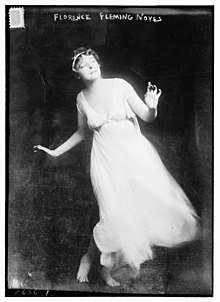Florence Fleming Noyes
Florence Fleming Noyes (1871–1928) was an American classical dancer.[1]

Florence Fleming Noyes circa 1913
_276006v.jpg)
Noyes as Liberty, and her attendants. A suffrage tableau on the steps of the Treasury Building. March 3, 1913
Biography
She was born in 1871. In 1912 she opened her first dance studio in Carnegie Hall and in 1913 she dressed as Liberty at the Capitol in Washington, D.C. as part of a tableau vivant to bring publicity for the cause of women's right to vote.[2][3] In 1921 she founded two dance camps in Portland, Connecticut. They were the Shepherd's Nine for women, and the Junio.[2] She died in 1928.[4]
Publications
Legacy
- The Noyes School of Rhythm in Manhattan, New York (1912-2002)[2]
- The Noyes School of Rhythm in Portland, Connecticut[1]
gollark: If you try and use it to proxy, I don't know, telnet, it'll not work.
gollark: Isn't HTTP.
gollark: I have nginx as a static file server (for my static-site-generated website), but a few things need to be dynamic, so I forward those URLs to actual backends.
gollark: Or proxy to other stuff, obviously.
gollark: Because it can basically only serve static files.
References
- Thompson, Nancy (August 8, 1995). "Dancers Tap". Hartford Courant. Retrieved 2008-12-12.
Noyes School of Rhythm ... Florence Fleming Noyes, a contemporary of Isadora Duncan and a dancer in the early years of the 20th century, saw rhythm, movement and free dance as a way ...
- "The Noyes School of Rhythm". The Noyes School of Rhythm. Archived from the original on May 14, 2008. Retrieved 2008-12-20.
Classes have been offered continuously in New York City (until 2002) since 1912 when Florence Fleming Noyes opened her first studio in Carnegie Hall. In 1921 she founded two camps in Portland, Connecticut: Shepherd's Nine for women, and the Junior School with separate programs for children, families, and men.
- "No Flimsy, Flowing Robes in Coming Washington Tableaux". The New York Times. February 7, 1913. Retrieved 2008-12-12.
Florence Fleming Noyes, the classical dancer, who will impersonate Liberty. will wear sandals, no matter how cold it is.
- "The Dance:Lost Russians – Stars of the Old Ballets Now Living in the United States Would Make a Significant Company". The New York Times. February 12, 1928. p. 6X. Retrieved 2008-12-20.
The death of Florence Fleming removes from the field of rhythmic education one ...
This article is issued from Wikipedia. The text is licensed under Creative Commons - Attribution - Sharealike. Additional terms may apply for the media files.